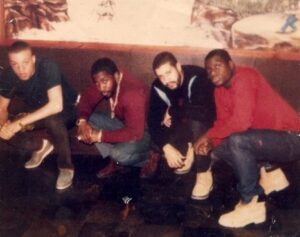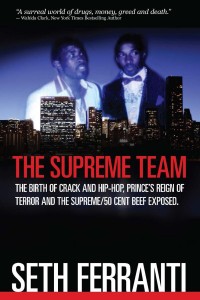 “Back then the game was the game. Everybody stood by the rules. Soldiers were soldiers,” Bing says. This was the era from which Preme and the team emerged. It was a time when men were men, and the consequences of snitching were clear. In Queens snitching was forbidden. It was embedded in the youngster’s DNA. Omerta played a powerful role in shaping the lost generation in terms of how they saw the world. Nobody took liberties and keeping your mouth shut became a sign of a go hard gangster.
“Back then the game was the game. Everybody stood by the rules. Soldiers were soldiers,” Bing says. This was the era from which Preme and the team emerged. It was a time when men were men, and the consequences of snitching were clear. In Queens snitching was forbidden. It was embedded in the youngster’s DNA. Omerta played a powerful role in shaping the lost generation in terms of how they saw the world. Nobody took liberties and keeping your mouth shut became a sign of a go hard gangster.
“Not all gangsters are outlaws and not all outlaws are gangsters,” Prince said. “Stand up people do not fold or run when faced with difficulty. We analyze and determine the best course of action, holding firm to the principle of never harm another to save yourself. We understand that every action we choose has consequences. Therefore, before we act, we first settle within our hearts and minds that we can handle the consequences, whether it be beneficial or detrimental to ourselves and the lives of those we risk our life and freedom for.” These were the ideals Preme embedded in the team, and this was an era when a man had to be verified by someone who was qualified in order to be certified.
There were rules in the dope game and prospective dealers or wanna be gangsters had to prove their mettle to the hierarchy of already established hustlers in their hood. They were tested before they were allowed to put a foot in the door. Not just anybody was allowed to be a player in the game. Dudes like Preme had to pay their dues, as did all the members of the Supreme Team. “Niggas was always hustling before they was selling drugs,” Bing says. “They were robbing banks, burglarizing, shooting dice, robbing, sticking dudes up, gambling. The team did banks and shit. That’s how they started in 1982. We always had our hustles before we started dealing drugs and we were gangbanging.” Down on the block the team learned the ropes of the game.
The O.G.’s taught them to follow a time honored tradition. Bing explains, “Death before dishonor. You get arrested, you closed your mouth and kept it shut and went to jail. That was installed in me as a kid by older guys who I came up under in the streets. The way I grew up and the people I looked up to showed me morals and principles. They told me that when you go out to hustle, you hold your own.” The streets were vicious and the most important lesson was to trust no man.
Tuck explains, “Trust no man was the most important lesson I ever learned. The only thing was I learned it too late. There are no rules to that life. No loyalty, no love just the street code, no snitching.” The criminal intention was to defeat the system. That was why the street code was so important. It held that the authorities were the pre-eminent enemies, above all else. A true gangster wouldn’t rat out his worst enemy, even on his deathbed.
“When we was coming up there was a code of conduct,” Supreme said. By following this code of conduct the team gained power and respect. “We followed the old school street code. No rape, stealing from each other. No shit like that,” Bing said. “We respected people, people respected us or else.” Because in the streets that was how dudes got their props, by instantaneous violence. That was how hustlers acquired that gangster pedigree. When it jumped off, the drama got thick with the quickness. It could get hectic in a New York minute. Still, there was another angle to it, the way the Mafia did things.
True professional criminals who chose to traffic on the dark side of American society didn’t seek public acclaim. “A heavy handed gangsta lives in the shadow of death,” the Queens hustler said. Being the man behind the man implied an inner confidence that allowed others to assert themselves in the arena of public aggrandizement, while knowing all along that the real power resided offstage in the hands of the marionette. That was how organized crime worked. That was the model the Supreme Team followed, but they put their twist on it. They weren’t the Italian Mob. They were young and black; they were the hip-hop Mafia, and kings of the inner-city.
The flashy hustlers set the standard and became role models for the neighborhood, flaunting their alluring lifestyle, which was well beyond the reach of working class Queens. “Ronnie Bumps, the Corleys, Pretty Tony on Liberty Avenue, Tommy Mickens on Rockaway, these were the niggas we looked up to. These were the niggas that set shit up for us,” Bing said. These were the youngsters who came together to form the Supreme Team, who grew up under these hood stars and learned the game from them. “That was our real life, how we came up,” Bing said. “You see it all in hip-hop, but back then that was the streets.” The youngsters got their style and swagger from these ghetto celebrities and rocked it.
“The team was the flyest crew in Queens,” the original member says. They talked the talk and walked the walk, becoming lords of the ghetto in the process. The young drug dealers and hip-hop scene that would sweep the nation in the 1990s and popularize Queens’ culture owed a debt to these icons. Dripping in gold and carrying guns, with neat clothes and flashy cars they popularized thug culture.
“Dudes from Queens always stayed fly,” Bing says, “Queens was always fly niggas, getting-money niggas. We had to prove ourselves though.” The Supreme Team had a reputation to earn, a reputation to uphold. A legacy was born, and they embraced and adopted it. That reputation earned Queens a place in the power struggles of the streets and in the rap world. Queens became hip-hop, and the Supreme Team epitomized Queens. Not surprisingly, the moment Run DMC started making noise in hip-hop in the early-’80s was also when the real street thugs started making inroads into the business. Street life’s growing intersection with rap and the music world would impact both deeply. There were six degrees of separation between hip-hop stars and the criminals they emulated which would affect Supreme much later.
Queens became where it was at, and dudes from the borough started to stick their chests out. It was a drug game thing; it was a hip-hop thing; it was a Queens’s thing. It was a growing mentality and attitude that they developed, nurtured, and created. All the neighborhoods in Queens were now being heard together with one defiant voice. Respect was what that voice demanded, and dudes from all parts of the city knew that Queens’ hustlers were getting theirs. Queens went from faking it to running it. They were getting their respect in the streets, in the prisons and in hip-hop. “It was the niggas from Queens making all the noise,” Bing says. “We started all this gangster shit.”
With his team supporting his moves, Preme’s power on the streets of South Jamaica grew. The Southside was gradually coming under the sway of the team. “From’ 81-’85 everybody was home,” Bing says. “The team was in full effect and dominated the streets.” As they became more entrenched in the drug game, dudes got busted, cases would come and go, and they would lose members to the criminal justice system. But their first run was uninterrupted, and during this time they forged their legend in the hood.
At the same time, hip-hop was evolving and becoming a force in the inner-city. It was still New York street music, but hip-hop was growing and getting bigger. It was becoming a culture that would dominate the nation just as the Supreme Team dominated the Southside, the same hoods that the rappers grew up and congregated in. Run DMC would drive through the ghetto, back and forth, hanging out. They were everywhere, very present and accounted for on the streets. They looked and dressed like the guys from around the way, like the dudes playing basketball in the parks, the fly guys hanging around the clubs and projects. The hustlers in Queens embraced Run DMC long before they were stars when hip-hop was nothing.
Shakim Bio Chemical explains, “Rap game put in work, dope game put in work. I come from an era where hip-hop wasn’t on vinyl yet. The music was being played in the purest form in the parks which caused a reaction everywhere it vibed. Growing up, there weren’t too many heroes to look up to. My era produced the graffiti artist, the break dancers, DJ’s, the MC’s and shit like that. People claimed that these kids weren’t doing nothing but making a lot of fucking noise, now those kids and millions after them are what’s up. I used to go to high school spitting the vilest shit ever and crushing niggas in rap battles, but music didn’t appear to be the future back then. I became a product of my environment, and I began to hustle.”
The culture of Queens clashed as the dope game and hip-hop strove for prominence. The drug dealers became street legends that were lionized in hip-hop’s lyrical lore and the chronicles of gangster infamy. By the mid-’80s hip-hop was pushing boundaries in the musical world, and major labels started signing rappers to deals. But the street vibe and influence of drug dealing organizations like the Supreme Team were at the forefront of the genre. The lasting impression they left, which forged the flashy arrogance of ’80s hip-hop, wasn’t a coincidence. Hip-hop and hustling were closely related as were the people who resided jointly in both worlds. The links between the growing hip-hop nation and the new-style, organized crime networks would prove resilient.
 This is an excerpt from The Supreme Team. You can order it from Gorilla Convict or www.amazon.com
This is an excerpt from The Supreme Team. You can order it from Gorilla Convict or www.amazon.com


